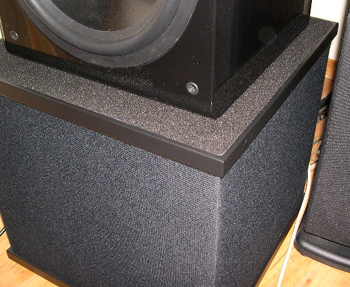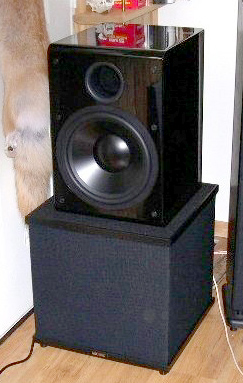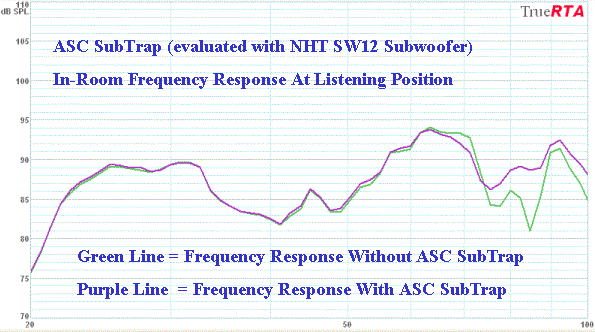|
|
 |
|
Specifications:
● 18" Version is Effective
Down to 50 Hz
● 22" Version is Effective Down to 30 Hz
● MSRP: 18" Version - $438 USA; 22" Version - $548 USA
ASC Acoustic Sciences Corporation
www.acousticsciences.com
|
|
Introduction
Years ago, acoustic treatments were largely the domain of serious audiophiles
looking to extract that last ounce of performance from their systems.
Fortunately, talk of room acoustics is becoming more commonplace in the main
stream audio and home theater community.
Enthusiasts are realizing that the
room itself has a significant influence on the sound and performance of their
HT and hi-fi systems. Secrets recently featured articles on the
methods
and materials for acoustic treatments, and
treating its sound lab.
It is heartening to see enthusiasts experimenting with speaker and subwoofer
placement, adjusting phase, balancing and calibrating their systems, taking
basic acoustic measurements like frequency response, and even using parametric
equalizers. And yet even with all these tools and tweaks at our disposal,
properly controlling room acoustics is still the foundation upon which great
sound is built. That's where companies like Acoustic Sciences Corporation (ASC)
come in.
ASC was founded by acoustic engineer Art Noxon in 1984, and over the last
twenty years, ASC has established a well known reputation in the field of
acoustic treatment. ASC's patented Tube Trap was the world's first
corner-loaded acoustic bass trap, and continues to be the standard in
recording studios, audio listening rooms, home theaters, and concert halls.
Indeed, I noticed several ASC Tube Traps in the Polk Audio suite at CES 2005.
The Design
The SubTrap - a new product at ASC - is designed to be placed under your subwoofer, to provide vibration
damping and acoustic trapping of excess low frequency reverberant energy. The SubTrap is cube shaped, and comes in two sizes: 18” and 22”. According to Art Noxon, the 22” model will provide more bass trapping capability (compared to
the 18” model) in the 40 Hz region. If your subwoofer has an irregular shaped
footprint, custom sizes are also available by special order. Because it fits
most under subwoofers, ASC sent me their 18” SubTrap for evaluation.
I was impressed by the build quality and high level of fit and finish on the
SubTrap. There are four heavy duty rubber feet, and the base and top plates
are constructed of black semi-gloss painted MDF. The sides are covered in
automotive grade woven fabric, and the top plate is covered with a low knap
carpeting. A classy looking black and gold acrylic nameplate graces the bottom
center.
 ASC
claims the SubTrap can support 250 pounds; I don't weigh quite that much, but
sitting and standing on the SubTrap caused no flexing or bowing whatsoever.
This is a strong and heavy duty product. It is also remarkably light for its
strength, weighing only about 22 pounds. ASC
claims the SubTrap can support 250 pounds; I don't weigh quite that much, but
sitting and standing on the SubTrap caused no flexing or bowing whatsoever.
This is a strong and heavy duty product. It is also remarkably light for its
strength, weighing only about 22 pounds.
The Technology
ASC calls the SubTrap an “Iso-deck”, meaning it mechanically damps vibrations
from the subwoofer and prevents them from being transmitted to the floor.
Enthusiasts with wooden flooring over an open space will find the SubTrap
particularly useful, as this flooring arrangement is quite susceptible to
flexing, vibration transmission, and self-noise. Some enthusiasts like feeling
floor vibrations, claiming it enhances HT low frequency special effects. Count
me among the dissenters; even for HT applications, I prefer to hear only the
subwoofer, unfettered by spurious floor resonances.
The flooring in my evaluation room is Armstrong laminate over poured concrete,
so I don't have much of an issue with floor vibration. But even concrete transmits
some minor level of vibration, albeit over a narrow bandwidth and very low
amplitude. So, enthusiasts with concrete flooring can still reap the
isolation benefits of the SubTrap.
Experimenting with subwoofer placement can help reduce the effect of
horizontal axial room modes at the listening position, but it does nothing to
prevent the vertical axial mode (typically 70 Hz) common with an 8 foot
ceiling height. The SubTrap changes all that by elevating the subwoofer and
moving it away from the mode pressure zone at the floor interface. But what
really makes the SubTrap unique is the acoustic bass trap housed inside the
enclosure. This bass trap is specifically tuned to absorb any residual
floor/ceiling mode build-up.
Shown below are diagrams representing the effect of the floor/ceiling
resonance, the SubTrap operation, and also a cut-away view of the SubTrap
showing the acoustic principles of the bass trap.


In-Room Testing
Set-Up: To evaluate the SubTrap, I removed all other bass traps from my
test room. I used an NHT SW12 subwoofer, since it fit very well on the
18” SubTrap. I connected the signal generator directly to the subwoofer
input, and placed the microphone at head level at the primary listening position.
Frequency Response: The SubTrap significantly smoothed out the FR in the
65 Hz -100 Hz bandwidth, slightly reducing the response peak at 70 Hz, and
canceling out some jagged nulls in the 75 Hz - 90 Hz region.

RT/30: This test measures the amount of time it takes for select frequencies
to drop in amplitude by 30 dB after the test signal terminates. As shown in
the table below, the ASC SubTrap significantly reduced the RT/30 times in the
40 Hz - 60 Hz bandwidth. I was particularly impressed with the nearly 400 ms RT/30
reduction at 50 Hz. Be careful not to misinterpret the test result at 80 Hz.
Because the SubTrap eliminated some nulls in the 65 Hz - 90 Hz bandwidth, the
frequency response in this region has more inherent acoustic energy with the SubTrap in place, so the RT/30 times will be higher.
|
Frequency (Hz) |
RT/30 (ms),Without ASC SubTrap |
RT/30 (ms)
With ASC SubTrap |
Difference (ms) |
|
20 |
511 |
503 |
8 |
|
25 |
382 |
353 |
29 |
|
31 |
461 |
418 |
43 |
|
40 |
1351 |
1253 |
98 |
|
50 |
1221 |
839 |
382 |
|
63 |
424 |
398 |
26 |
|
80 |
275 |
298 |
-23 |
Buzz/Rattle Test: I ran a slow reverse sine sweep (120-20 Hz over 45 seconds)
through the subwoofer, listening for buzz and rattle in the evaluation room.
Adding the SubTrap without question reduced the quantity and magnitude of buzz
and rattle in the room. This is a result of both the isolation platform
reducing vibration transmission through the floor, and also the bass trap
reducing excessive reverberant bass energy in the room.
Listening
Using the NHT SW12 subwoofer, I evaluated the SubTrap on several music
selections for balance, definition, pitch, coherence, and deep extension. As
with the objective tests, I removed all other bass traps from the room before
conducting the listening session.
For digital bass management, the main speakers were set to “Small” with a
crossover frequency of 80 Hz. The digital bass management circuit imposes a
2nd order high pass filter on the speakers, and a 4th order low pass filter on
the subwoofer. The low pass filter on the subwoofer was bypassed.
My subjective impression is that the SubTrap provides a more cohesive and
coherent sonic presentation, with less boom and overhang. The bass quality is
more ethereal, seeming to emanate directly from the soundstage, rather than
the subwoofer itself. Part of this improvement could be due to the SubTrap
elevating the subwoofer and placing it closer to the main speakers, creating
more of a point source.
While the SubTrap obviously cannot increase deep extension, the trapping of
excessive reverberant mid-bass energy allows the listener to hear the deepest
bass with more clarity, thus improving the perception of deep extension.
Provided below are my subjective ratings of the NHT SW12 subwoofer, both with
and without the ASC SubTrap.
|
Evaluation Criteria |
Without ASC SubTrap Rating (1-5) |
With ASC SubTrap Rating (1-5) |
Improvement |
|
Balance |
3.75 |
4.25 |
+0.50 |
|
Definition |
3.75 |
4.25 |
+0.50 |
|
Pitch |
3.75 |
4.00 |
+0.25 |
|
Coherence |
3.50 |
4.25 |
+0.75 |
|
Deep Extension |
3.75 |
4.00 |
+0.25 |
Conclusions
The ASC SubTrap works as advertised. It reduces vibration transmission through
the floor, improves the frequency response in the mid and upper bass regions,
reduces low frequency reverberant decay times, and it locates the subwoofer
closer to the height of the main speakers. Not surprisingly, this unique
combination of engineered performance features results in an audible
improvement in the bass quality. Discerning HT and hi-fi enthusiasts will
definitely appreciate how the ASC SubTrap extracts the best possible
performance from any subwoofer.
- Ed Mullen -
Terms and Conditions of Use

|


 ASC
claims the SubTrap can support 250 pounds; I don't weigh quite that much, but
sitting and standing on the SubTrap caused no flexing or bowing whatsoever.
This is a strong and heavy duty product. It is also remarkably light for its
strength, weighing only about 22 pounds.
ASC
claims the SubTrap can support 250 pounds; I don't weigh quite that much, but
sitting and standing on the SubTrap caused no flexing or bowing whatsoever.
This is a strong and heavy duty product. It is also remarkably light for its
strength, weighing only about 22 pounds. 




